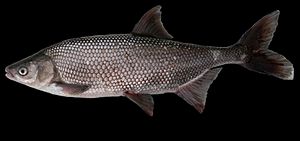Lavinia exilicauda facts for kids
Quick facts for kids Hitch |
|
|---|---|
 |
|
| Conservation status | |
| Scientific classification | |
| Synonyms | |
|
The hitch (Lavinia exilicauda) is a type of fish that belongs to the minnow family. It lives only in central California. This fish used to be very common there. Its name comes from a word in the Pomoan language, which is spoken by Native American tribes in California.
Description
The hitch fish has a unique shape. It is tall and flat from side to side, almost like a pancake. Its head is small, and its mouth points upwards. This helps it eat food from the surface of the water.
Most hitch fish are shiny silver all over. Younger fish have a black spot near their tail, but this spot fades as they grow older. Older fish also tend to become a bit darker in color.
The fin on its belly, called the anal fin, is longer than those of other minnows in California. It has 11 to 14 rays, which are like the bony supports inside the fin. The fin on its back, called the dorsal fin, has 10 to 13 rays. This fin is placed further back on its body, between its belly fins and its anal fin. The tail fin is large and has a deep fork, like a "V" shape.
Hitch fish can grow quite large for minnows, reaching up to 36 centimeters (about 14 inches) long. Because of their shape and size, they look a lot like the golden shiner fish. The hitch is also related to the California roach. Sometimes, these two types of fish can even breed together, creating mixed offspring.
What Hitch Eat and Where They Live
Hitch fish are omnivores, meaning they eat both plants and animals. They live in open water and munch on things like stringy algae, insects, and tiny water creatures called zooplankton.
You can find hitch in different watery places. They live in lakes, slow-moving parts of rivers and streams, and marshy areas called sloughs. These fish are very tough when it comes to temperature. They can live in both warm and cool water, more so than other native fish in California's Central Valley. They can also handle some salt in the water. For example, they live in Suisun Marsh, where the water is a little salty (7-8 parts per thousand salinity). They are also found in the Salinas River lagoon, which has even more salt (9 parts per thousand).
Distribution
Hitch fish live in several river systems in California. Their home includes the Sacramento River and San Joaquin River system in the Central Valley. They also live in the Russian River, Clear Lake, Pajaro River, and Salinas River.
Even though hitch fish used to be very common, their numbers are now going down. People once fished for them a lot in Clear Lake, but that is no longer the case. Scientists believe the main reason for their decline is that there isn't enough water flowing in the spring. This is because water is taken away for other uses, and dams block the rivers. These changes make it hard for hitch fish to find good places to lay their eggs.
See also
 In Spanish: Lavinia exilicauda para niños
In Spanish: Lavinia exilicauda para niños


